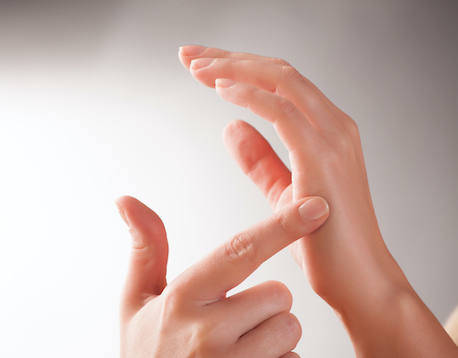Reviewed by Dr. Mary James, ND
Many women feel discouraged and disheartened by the advice they’ve received about fibromyalgia. The sleeplessness, extreme fatigue, and widespread chronic pain that accompany fibromyalgia can be unbearable for some women, but the medical community has long been stumped by this confusing and controversial condition. It was ignored by conventional medicine for years, and in some circles fibromyalgia is still questioned as a “real” diagnosis. But fibromyalgia is real, and there are thousands of women out there who deserve compassionate and effective care. We don’t have all the answers yet, but pain specialists and functional practitioners are working to get to the root of fibromyalgia and similar pain syndromes, to give you the answers you want and deserve.

In this article
- What is fibromyalgia?
- Stress, hormonal balance, and fibromyalgia — what’s the connection?
- An inside look at the pain — fibromyalgia and the central sensitization theory
- Women’s Health Network’s SHINE protocol — the natural approach for treating fibromyalgia
Recently the FDA approved medications (Lyrica, Cymbalta, and Savella) for fibromyalgia patients, and many are thrilled that the medical community is finally recognizing their struggle. But women with fibromyalgia deserve more than a prescription for their pain and suffering, especially since the initial FDA reviewers of Lyrica (which was first examined for treatment of diabetic nerve pain) felt its effects were unimpressive. On top of this, Lyrica has some unappealing side effects — including weight gain, swelling, dizziness, and drowsiness (the last thing a fibromyalgia patient needs!).

Fibromyalgia tender points
Location of the 9 paired tender points comprising the 1990 American College of Rheumatology criteria for fibromyalgia.
There is a better way.
Lots of women do recover from fibromyalgia, and others improve tremendously by learning to nurture their bodies from the inside out. This can be considered a condition that strikes at the very core of a woman’s being, where there can be many underlying issues to uncover — from sleep and diet, to viruses and bacterial infections like Lyme disease and other co-infections, to how we think and feel. It’s oftentimes a difficult road to travel. But you can feel good again, if you’re willing to roll up your sleeves, do some digging, and learn some new ways of being. Let’s take a closer look at fibromyalgia and your options for feeling better naturally.
The definition of fibromyalgia
Some chalk it up to an energy crisis in the body’s cells, others to mixed messaging between the muscles and the brain, but no one is really certain — yet — where fibromyalgia comes from. We do know that fibromyalgia patients have chronic pain in both the upper and lower, left and right parts of the body, and that it involves a physical response to stress. We also know from functional neural imaging that the brains of patients with fibromyalgia show greater activation than control patients when given the same stimulation. So there is clearly a physiologic difference in how these patients process pain in their brains.
The symptoms of fibromyalgia overlap with many other disorders, such as chronic fatigue syndrome (CFS), myofascial pain syndrome (MPS), multiple chemical sensitivities (MCS), temporomandibular joint dysfunction (TMJ) and interstitial cystitis (IC), and that’s just a few. This wide overlap can make it very difficult to diagnose, and even more so to treat appropriately. In 1990, the American College of Rheumatology came up with the following diagnostic criteria for fibromyalgia:
Many nutritional, metabolic, and infectious issues can lead to persistent pain. Consider talking with your practitioner about tests for the following concerns:
Nutritional
- Low ferritin
- Low B12
- Low folic acid (in the blood or red blood cells)
- Low 25-hydroxy vitamin D
- Low vitamin C, B1, and B2
Metabolic
- Hypothyroidism
Infectious
- Lyme disease
- Hepatitis C
- Ova and parasites
- Enteroviruses
- Other co-infections
Toxic
- Heavy metals
- Pesticides
- Jet fuel
Adapted from Gerwin, 2005. (See references.)
- At least 3 months of widespread pain (present in the left and right side of the body, above and below the waist, and in the axial skeleton)
PLUS
- 11 of the specified 18 points are tender on digital palpation (see image of fibromyalgia tender points)
It’s worth noting here that these criteria were developed for research purposes, and they aren’t all that practical for those of us who see patients every day — there is a lot more to fibromyalgia than the above bullets would imply. For starters, we all know pain can vary on a day-to-day basis, so a tender point today may not feel the same tomorrow. Oftentimes women don’t have 11 tender points every day. Research shows that exposure to physical, emotional, or environmental stressors can trigger symptoms — so on a bad day you may experience more pain than you do on a good one. What’s more, many practitioners lack training on how to locate or distinguish fibromyalgia tender points from the trigger points associated with other kinds of musculoskeletal pain, like myofascial pain syndrome (MPS).
So it’s not surprising that people can be incorrectly diagnosed. If you suspect you have fibromyalgia, we encourage you to find a practitioner who is highly experienced in dealing with pain syndromes. It’s likely that fibromyalgia is more a composite of symptoms than a specific disease, so it’s best to focus on alleviating symptoms rather than searching endlessly for a definitive diagnosis.
Pinpointing an exact cause for your fibromyalgia might also be an unrealistic goal, but consider looking into nutritional, infectious, hormonal, and metabolic disorders as possible pieces to the equation — as well as your emotional history. The chart at right lists several issues that may lead to persistent myalgias and can be linked with fibromyalgia. Depending on how your lab results come back, your treatment may vary — especially if the root cause of your pain is infectious. So it’s important to get as complete a picture as possible.
| Mechanical causes | Structural Postural Ergonomic |
| Medical causes | Infectious diseases Inflammatory disorders Immunological/allergic Nutritional disorders Hormonal disorders |
(Adapted from Gerwin, 2005 — see references.)
How stress and hormones are linked to fibromyalgia
As many women already know, our hormones are integral to our health. The master gland that controls our hormones is called the hypothalamus. Situated deep within our brain, the hypothalamus sends biochemical messages to the thyroid, adrenal glands, and ovaries (among others) through the pituitary gland, to regulate our metabolic balance, immune system, autonomic nervous system, and more. In turn, our tissues talk back to the hypothalamus by way of chemical messaging. If you’ve read our articles on hypothyroidism before, the HPA and HPT axes may sound familiar — these are the communication loops between the hypothalamus, the pituitary, and the adrenals (HPA) and the thyroid (HPT). Though we don’t understand the exact mechanics, it is becoming clear that these feedback loops strongly influence the symptoms we see in fibromyalgia. Let’s take a closer look at three important hormone-producing locations in the body.

Research tells us that fibromyalgia patients may suffer from disruptions in the hormonal sequences shown above. Since the hypothalamus and pituitary are central in governing many hormonal cascades, an imbalance in one area could easily affect the others. Scientists trace some of these disruptions back to environmental and genetic influences, as well as psychological stress.
(Adapted from Gupta, A., & Simon, A., 2004. -see references.)
Adrenal glands. One of the primary responsibilities of our adrenal glands is to release cortisol. We have a daily cortisol cycle, and we also release it when we’re under stress. Many fibromyalgia patients describe “crashing” under stress, which is most likely related to an adrenal imbalance. One review done in 2004 proposed that chronic stress leading to fibromyalgia is connected to a dysfunction in the HPA axis. The research suggests a connection between past emotional trauma and disrupted cortisol rhythms in fibromyalgia patients. But what’s remarkable is that when a woman takes steps to heal toxic emotions and support her adrenal health, not only does her stress response dramatically improve, but so do her fibromyalgia symptoms.
Ovaries. Women with fibromyalgia – seem to experience more severe symptoms premenstrually, and sometimes after menopause as well. This is because estrogen, progesterone, and possibly even testosterone can all affect pain and fatigue in the body. A study done in 2005 looked at these connections, and around 50% of the women in the study said they experienced more pain and fatigue during their periods, 25% stated that their fibromyalgia symptoms started with menopause, and 26.4% said the severity of their symptoms increased after menopause. So it makes sense that by gently balancing our hormones through adrenal, thyroid, and ovarian support, we can lessen the burden of fibromyalgia. But here’s some good news to keep in mind: function in fibromyalgia patients does tend to improve over the years, and symptoms decrease with age as patients develop effective coping strategies.
Thyroid. Once a woman’s HPA axis is off-kilter, it’s much more likely her hypothalamic-pituitary-thyroid (HPT) axis will suffer, too. The two are intimately connected — see our diagram of the HPA and HPT axes for a visual. Very often when the thyroid is imbalanced, it actually stems from an adrenal imbalance. Recent research has been demonstrating an association between thyroid conditions and fibromyalgia, which seems more prevalent in women in menopause. While these relationships remain poorly understood, the symptoms we see with hypothyroidism — low body temperature, poor immune function, fatigue, and achiness — can certainly contribute to more intense fibromyalgia symptoms. So the good news is that when we address the hypothyroidism, again, fibromyalgia symptoms can also improve. (See our thyroid health section for more on how to support your thyroid.)
An inside look at the pain — fibromyalgia and the central sensitization theory

It’s hard to know exactly why fibromyalgia patients feel more pain than others, but recent research in this area is giving us clues. The problem is thought to begin in the deep tissues of the muscles and joints. There is a persistent tightening of muscles, caused by a variety of influences, which leads to poor sleep. Without sleep, the muscles don’t recover, which can lead to continuous back-and-forth signaling between the muscles and your central nervous system. Over the long term, this changes the way our central nervous system (spinal cord and brain) processes outside stimuli, amplifying pain and sensitivity. This theory, which is one of many in the science community, is known as central sensitization.
One of the things I find most interesting about this theory is that the causes and effects of fibromyalgia are thought to be bidirectional. In other words, structural imbalances can cause a tightening of muscles, while tight muscles can lead to structural imbalances. Similarly, poor sleep can lead to tightening of muscles, and tight muscles can lead to poor sleep. You get the idea. It’s also interesting that sleep-disordered breathing has recently been proposed as “the missing link” in how pain syndromes develop. To the right is just one possible bidirectional scenario — you might substitute structural imbalances for poor ergonomics, or any of the other conditions and triggers shown above feeding into fibromyalgia syndrome.
The next question is, how can we stop this cycle? Two of the best and most basic steps are to foster good sleep and be sure you’re getting the nutrients your muscles need to function properly. But there is so much more you can do to naturally decrease your pain or even eliminate it altogether.
Women’s Health Network’s SHINE protocol — the natural approach for treating fibromyalgia
Prescription medications for treatment of fibromyalgia may help in the short term, but using drugs like Lyrica, Cymbalta, and Savella is more like putting a finger in the dam to stop the rush of water than a permanent solution. In 2007, Dr. Jacob Teitelbaum published From Fatigued to Fantastic!, a wonderful book on fibromyalgia and chronic fatigue syndrome. In his book, Dr. Teitelbaum offers a natural approach called the SHIN protocol, where he asks readers to address Sleep, Hormonal imbalances, Infections, and Nutrition.
Research shows that our emotional history almost universally plays a role in our health, so we add an E to Dr. Teitelbaum’s protocol — encouraging women to explore their Emotions in relation to fibromyalgia. This gives us SHINE:
-
- Sleep. Most patients with fibromyalgia list nonrefreshing sleep as a prime concern. To give your muscles and nervous system a chance to heal, you will need to get the bottom of your sleeplessness. You may want to start by reviewing our article on insomnia. If you suspect deeper sleep problems such as apnea or other sleep-disordered breathing, consider a referral to a sleep specialist. You might also consider supplementing with melatonin or other botanical nervines like chamomile, passionflower and valerian. We offer melatonin and Serinisol, a powerful herbal solution to help lower cortisol and help you sleep.
- Hormonal and adrenal balance. Balancing your adrenal, thyroid, and ovarian hormones can make a huge difference in fibromyalgia. At Women’s Health Network, we recommend gentle phytotherapy, which works with your innate metabolic pathways. For best results, we suggest looking for products containing botanical nervines and/or adaptogens. We developed Adaptisol, a powerful herbal product to promote adrenal balance. Adaptisol combines astragalus root, Siberian ginseng (also known as eleuthero), Rhodiola and Cordyceps to help restore energy and protect your body from the negative effects of stress.
- Immune health. Infectious agents like bacteria, enteroviruses, yeasts, or parasites could be one of the causes of your symptoms, and we always look to rule these agents out in our patients with fibromyalgia. Epstein-Barr virus (EBV) and Lyme disease are just two of many pathogens commonly confused with, or seen in association with fibromyalgia and chronic fatigue syndrome. Talk to your practitioner about being tested and treated appropriately. Another avenue to explore is possible allergies or sensitivities triggering or exacerbating your symptoms. The big ones in fibromyalgia patients are gluten, sugar, preservatives, and other food additives. Check out our articles on allergies and gluten sensitivity — and consider an elimination diet to see if this makes a difference for you. Even if you aren’t dealing with specific infections or sensitivities, it’s wise for a patient with fibromyalgia to shore up her immune system. Studies show that taking a probiotic supplement boosts body-wide immunity.
- Nutrition. Providing your body with whole, fresh foods, especially an abundance of fruits, vegetables, and high-quality fats and protein, is simply the most natural, down-to-earth, and cost-effective way to support your body. Because a stressed-out nervous system can really chew through nutrients, we also recommend a high-quality daily multivitamin/mineral complex/fish-oil regimen like the one we offer in our Health Programs. Our muscles, nervous system, adrenal glands, immune system, and the body as a whole need nutrient replenishment to carry out their everyday processes!
- B-complex vitamins for energy, immunity, nerve and brain function
- Magnesium for producing energy in muscles
- Selenium for optimal immune function
- Vitamin C for oxidative stress
- Omega-3 fatty acids for cell membranes and mood
- Vitamin D for mood, immunity, and the musculoskeletal system
- Emotions. If we bury the emotional factors that play into our physical state, over time the issues will find a way to display themselves in other physical ways. In fact, a study done in the 1990’s known as the Adverse Childhood Event (ACE) Study proves it. This study found specific evidence for how negative childhood experiences can influence our health. We often hold onto memories of our past and resort to behaviors that worked for us as children. The problem is, these behaviors rarely serve us as adults and, by repeatedly engaging in them, we deprive ourselves of the opportunity to resolve core issues. Women with fibromyalgia often hold deep criticism and judgment of themselves, and when they become more forgiving and loving with themselves, healing is much less difficult. There are many options available to help us untangle difficult emotions, including the Emotional Freedom Techniques, the Quadrinity Process, and cognitive behavioral therapy, to name just three. Women who are willing to delve into deeper emotional issues develop coping strategies that improve their fibromyalgia.
In addition to the SHINE protocol, there are several other natural treatment concepts I’ve found helpful for my patients with fibromyalgia. Consider the following measures to bolster your fibromyalgia treatment:
- Detox. From pesticides to jet fuel, to the mercury in our fillings, our bodies are constantly trying to filter out toxins. Fibromyalgia patients can lighten the load on their overburdened bodies by stimulating their natural detoxification systems. This might include the use of saunas, steam baths, mineral baths, and low-intensity exercise to induce sweat. It may also mean exploring ways to remove toxic chemicals from your environment. For example, you may try to be as “green” as possible at home, or perhaps look into talking with a biological dentist about removing mercury fillings in your mouth.
- Exercise. Due to fatigue and muscle pain, many people with fibromyalgia have adopted a fairly sedentary lifestyle. It can seem like an insurmountable barrier to exercise, but once you get started the benefits accrue almost immediately. We’re not just talking in terms of improved fitness; you can also expect to experience decreased pain, more restful sleep, improved cognitive function, a sunnier emotional outlook — all told, better overall quality of life. A lot of research has been done on aquatic fitness programs — everything from “deep-water running” to aqua-robics to isokinetics in warm seawater pools — demonstrating tremendous benefits for fibromyalgia. Other research suggests the addition of whole-body vibration (WBV) to safely reduce the pain and fatigue of fibromyalgia better than exercise alone. Some long-term planning may also be needed to help you stick with it, but in the meantime, we encourage you to make a gentle start.
- Mind-body work. Along the same lines of benefits derived from exercise, body-awareness practices such as qi gong and yoga, are said to improve “movement harmony,” and breathing exercises and mindfulness meditation can help diminish symptoms of fibromyalgia. Studies suggest all these methods work in part by way of calming the “noise” in the central nervous system. You might also consider other forms of mind–bodywork, like acupuncture, biofeedback, massage, osteopathic manipulation, Feldenkrais, Alexander technique, and chiropractic. These may help in correcting structural imbalances and in regulating pain. Some women also report benefit in guided imagery exercises, such as Belleruth Naparstek’s meditation to help with fibromyalgia and chronic fatigue.
Find hope in your own light
We all glow in our own unique ways, and when we are feeling good, the world can feel our warmth and positive energy. Fibromyalgia can dim this light, making us too tired, too discouraged, and too achy to find hope in anything, let alone feeling better. Especially if you’ve been told by your practitioner, or by several practitioners that there is nothing they can do — or worse, that your symptoms aren’t real — it can seem like you just have to live with this. But please know that you don’t have to live in pain, and you don’t have to be on a prescription medication for the rest of your life, either.
Fibromyalgia is a syndrome caused and influenced by many, many factors, and if you start to work on even one or two of these factors, you will find that light within starting to shine again. With this new hope, you can regain the energy to work on more aspects of your life that may be affecting your health — and in time, you’ll be enjoying each brand new day.
1 Gerwin, R. 2005. A review of myofascial pain and fibromyalgia — factors that promote their persistence. Acupunct. Med., 23 (3), 121–134. URL: https://www.acupunctureinmedicine.org.uk/servearticle.php?artid=499 (accessed 03.26.2009).
2 Berenson, A. 2008. Drug approved. Is disease real? NYT. URL: https://www.nytimes.com/2008/01/14/health/14pain.html (accessed 03.09.2009).
Prohealth. 2009. FDA gives milnacipran green light for fibromyalgia treatment — third to be approved, after Lyrica and Cymbalta. URL: https://www.prohealth.com/library/print.cfm?libid=14247 (accessed 01.27.2009).
3 Berenson, A. 2008.
4 Teitelbaum, J. 2007. From Fatigued to Fantastic!, 3rd ed., 12. NY: Avery.
5 Dadabhoy, D., & Clauw, D. 2006. Therapy insight: Fibromyalgia — a different type of pain needing a different type of treatment. Nat. Clin. Pract. Rheum., 2 (7), 364–372. URL: https://www.nature.com/ncprheum/journal/v2/n7/full/ncprheum0221.html (accessed 03.25.2009).
6 Dadabhoy, D., & Clauw, D. 2006.
7 Dadabhoy, D., et al. 2008. Evidence-based biomarkers for fibromyalgia syndrome. Arthrit. Res. Ther., 10 (4), 211–229. URL: https://arthritis-research.com/content/10/4/211 (accessed 03.26.2009).
8 Wolfe, F., et al. 1990. The American College of Rheumatology 1990 Criteria for the Classification of Fibromyalgia: Report of the Multicenter Criteria Committee. Arthritis Rheum., 33 (2), 160-172. URL: https://www.rheumatology.org/publications/classification/fibromyalgia/fibro.asp (accessed 02.02.2009).
9 Dadabhoy, D., & Clauw, D. 2006.
10 Gerwin, R. 2005. A review of myofascial pain and fibromyalgia — factors that promote their persistence. Acupunct. Med., 23 (3), 121–134. URL: https://www.acupunctureinmedicine.org.uk/servearticle.php?artid=499 (accessed 03.26.2009).
11 Gupta, A., & Silman, A. 2004. Psychological stress and fibromyalgia: A review of the evidence suggesting a neuroendocrine link. Arthritis Res. Ther., 6 (3), 98–106. URL: https://www.pubmedcentral.nih.gov/articlerender.fcgi?artid=416451 (accessed 03.27.2009).
12 Teitelbaum, J. 2007, p. 84.
Weissbecker, I., et al. 2006. Childhood trauma and diurnal cortisol disruption in fibromyalgia syndrome. Psychoneuroendocrinology, 31 (3), 312-324. URL (abstract): https://www.ncbi.nlm.nih.gov/pubmed/16274933 (accessed 04.14.2009.
McLean, S., et al. 2005. Momentary relationship between cortisol secretion and symptoms in patients with fibromyalgia. Arthritis Rheum., 52 (11), 3660–3669. URL: https://www3.interscience.wiley.com/cgi-bin/fulltext/112137702/HTMLSTART (accessed 04.14.2009).
See also:
Claes, S. 2004. Corticotropin-releasing hormone (CRH) in psychiatry: From stress to psychopathology. Ann. Med., 36 (1), 50-61. URL (abstract): https://www.ncbi.nlm.nih.gov/pubmed/15000347 (accessed 04.14.2009).
13 Pamuk, O., & Cakir, N. 2005. The variation in chronic widespread pain and other symptoms in fibromyalgia patients. The effects of menses and menopause. Clin. Exp. Rheumatol., 23 (6), 778-782.
14 Gerwin, R. 2005.
Cronan, R., et al. 2002. The influence of age on fibromyalgia symptoms. J. Aging Health, 14 (3), 370–384. URL (abstract): https://www.ncbi.nlm.nih.gov/pubmed/12146512 (accessed 03.26.2009).
15 Bazzichi, L., et al. 2007. Association between thyroid autoimmunity and fibromyalgia disease severity. Clin. Rheumatol., 26 (12), 2115–2120. URL (abstract): https://www.ncbi.nlm.nih.gov/pubmed/17487449 (accessed 04.14.2009).
Pamuk, O., & Cakir, N. 2007. The frequency of thyroid antibodies in fibromyalgia patients and their relationship with symptoms. Clin. Rheumatol., 26 (1), 55-59. URL (abstract): https://www.ncbi.nlm.nih.gov/pubmed/16541203 (accessed 04.14.2009).
Ribeiro, L., & Proietti, F. 2004. Interrelations between fibromyalgia, thyroid autoantibodies, and depression. J. Rheumatol., 31 (10), 2036–2040. URL (abstract): https://www.ncbi.nlm.nih.gov/pubmed/15468372 (accessed 04.14.2009).
16 Price, D., & Staud, R. 2005. Neurobiology of fibromyalgia syndrome. J. Rheumatol. Suppl., 75, 22–28. URL (abstract): https://www.ncbi.nlm.nih.gov/pubmed/16078357 (accessed 03.26.2009).
Wickes, D. 2005. Manipulative therapy and functional medicine: Clinical interactions between structure and function. In Textbook of Functional Medicine, ed. D. Jones & S. Quinn, 495. Gig Harbor, WA: Institute for Functional Medicine.
17 Martinez, D., & Cassol, C. 2008. Fibromyalgia and sleep-disordered breathing: The missing link. Arthrit. Res. Ther., 10 (6), 408. URL: https://arthritis-research.com/content/10/6/408 (accessed 04.15.2009).
Germanowicz, D., et al. 2006. Sleep disordered breathing concomitant with fibromyalgia syndrome. J. Bras. Pneumol., 32 (4), 333–338. URL (abstract): https://www.ncbi.nlm.nih.gov/pubmed/17268733 (accessed 04.16.2009).
Shah, M., et al. 2006. Sleep-disordered breathing among women with fibromyalgia syndrome. J. Clin. Rheumatol., 12 (6), 277–281. URL: https://www.ncbi.nlm.nih.gov/pubmed/17149057 (accessed 04.16.2009).
18 Belt, N., et al. 2009. Sleep problems in fibromyalgia and rheumatoid arthritis compared with the general population. Clin. Exp. Rheumatol., 27 (1), 35-41. URL (abstract): https://www.ncbi.nlm.nih.gov/pubmed/19327227 (accessed 04.14.2009).
19 Sarzi Puttini, P., & Caruso, I. 1992. Primary fibromyalgia syndrome and 5-hydroxy-L-tryptophan: A 90-day open study. J. Int. Med. Res., 20 (2), 182–189. URL (abstract): https://www.ncbi.nlm.nih.gov/pubmed/1521674 (accessed 03.25.2009).
Caruso, I., et al. 1990. Double-blind study of 5-hydroxytryptophan versus placebo in the treatment of primary fibromyalgia syndrome. J. Int. Med., Res., 18 (3), 204–209. URL (abstract): https://www.ncbi.nlm.nih.gov/pubmed/2193835 (accessed 03.25.2009).
20 [No author listed.] 2009. EnteroVirus Foundation. URL: https://www.enterovirusfoundation.org/index.shtml (accessed 04.14.2009).
[No author listed.] 2009. Research-focused enterovirus foundation website launched. URL: https://www.prohealth.com/fibromyalgia/library/showArticle.cfm?libid=14451&B1=EM041509F (accessed 04.14.2009).
21 de Andrade, S, et al. 2008. Thalassotherapy for fibromyalgia: A randomized controlled trial comparing aquatic exercises in sea water and water pool. Rheumatol. Int., 29 (2), 147–152. URL (abstract): https://www.ncbi.nlm.nih.gov/pubmed/18600327 (accessed 04.16.2009).
Evcik, D., et al. 2008. Effectiveness of aquatic therapy in the treatment of fibromyalgia syndrome: A randomized controlled open study. Rheumatol. Int., 28 (9), 885–890. URL (abstract): https://www.ncbi.nlm.nih.gov/pubmed/18278501 (accessed 04.16.2009).
Gusi, N., & Tomas–Carus, P. 2008. Cost-utility of an 8-month aquatic training for women with fibromyalgia: A randomized controlled trial. Arthritis Res. Ther., 10 (1), R24. URL: https://arthritis-research.com/content/10/1/R24 (accessed 04.16.2009).
Munguía–Izquierdo, D., & Legaz–Arrese, A. 2008. Assessment of the effects of aquatic therapy on global symptomatology in patients with fibromyalgia syndrome: A randomized controlled trial. Arch. Phys. Med. Rehabil., 89 (12), 2250–2257. URL (abstract): https://www.ncbi.nlm.nih.gov/pubmed/19061736 (accessed 04.16.2009).
Munguía–Izquierdo, D., & Legaz–Arrese, A. 2007. Exercise in warm water decreases pain and improves cognitive function in middle-aged women with fibromyalgia. Clin. Exp. Rheumatol., 25 (6), 823–830. URL (abstract): https://www.ncbi.nlm.nih.gov/pubmed/18173915 (accessed 04.16.2009).
Tomas–Carus, P., et al. 2007. Aquatic training and detraining on fitness and quality of life in fibromyalgia. Med. Sci. Sports Exerc., 39 (7), 1044–1050. URL (abstract): https://www.ncbi.nlm.nih.gov/pubmed/17596770 (accessed 04.16.2009).
Assis, M.R, et al. 2006. A randomized controlled trial of deep water running: Clinical effectiveness of aquatic exercise to treat fibromyalgia. Arthritis Rheum., 55 (1), 57-65. URL: https://www3.interscience.wiley.com/cgi-bin/fulltext/112395551/HTMLSTART (accessed 04.16.2009).
22 Alentorn–Geli, E., et al. 2008. Six weeks of whole-body vibration exercise improves pain and fatigue in women with fibromyalgia. J. Altern. Complement. Med., 14 (8), 975–981. URL (abstract): https://www.ncbi.nlm.nih.gov/pubmed/18990045 (accessed 04.16.2009).
23 Mennerkorpi, K., 2005. Exercise in fibromyalgia. Curr. Opin. Rheumatol., 17 (2), 190–194. URL (abstract): https://www.ncbi.nlm.nih.gov/pubmed/15711234 (accessed 04.16.2009).
24 Haak, T., & Scott, B. 2008. The effect of Qigong on fibromyalgia (FMS): A controlled randomized study. Disabil. Rehabil., 30 (8), 625-633. URL (abstract): https://www.ncbi.nlm.nih.gov/pubmed/17852292 (accessed 03.24.2009).
Langhorst, J., et al. 2008. [Alternative and complementary therapies in fibromyalgia syndrome.] Schmerz, 22 (3), 324-333. URL (abstract): https://www.ncbi.nlm.nih.gov/pubmed/18463899 (accessed 03.24.2009).
da Silva, G., et al. 2007. Effects of yoga and the addition of Tui Na in patients with fibromyalgia. J. Altern. Complement. Med., 13 (10), 1107-1113. URL (abstract): https://www.ncbi.nlm.nih.gov/pubmed/18166122 (accessed 03.24.2009).
Chen, K., et al. 2006. A pilot study of external qigong therapy for patients with fibromyalgia. J. Altern. Complement. Med., 12 (9), 851-856. URL (abstract): https://www.ncbi.nlm.nih.gov/pubmed/17109575 (accessed 03.24.2009).
Mannerkorpi, K. 2005.
Mannerkorpi, K., & Arndorw, M. 2004. Efficacy and feasibility of a combination of body awareness therapy and qigong in patients with fibromyalgia: A pilot study. J. Rehabil. Med., 36 (6), 279-281. URL (abstract): https://www.ncbi.nlm.nih.gov/pubmed/15841606 (accessed 03.24.2009)
Astin, J., et al. 2003. The efficacy of mindfulness meditation plus Qigong movement therapy in the treatment of fibromyalgia: A randomized controlled trial. J. Rheumatol., 30 (10), 2257–2262. URL (abstract): https://www.ncbi.nlm.nih.gov/pubmed/14528526 (accessed 03.24.2009).
Clauw, D. 2003. Clinical research into alternative and complementary therapies: How do we tell if the glass is half empty or half full? J. Rheumatol., 30 (10), 2088–2089. Review. URL (no abstract available): https://www.ncbi.nlm.nih.gov/pubmed/14528498 (accessed 03.24.2009).
Creamer, P., et al. 2000. Sustained improvement produced by nonpharmacologic intervention in fibromyalgia: Results of a pilot study. Arthritis Care Res., 13 (4), 198–204. URL (abstract): https://www.ncbi.nlm.nih.gov/pubmed/14635274 (accessed 03.24.2009).
References for illustration: The stress–hormone–fibromyalgia link
Adapted from Gupta, A., & Silman, A. 2004.
1 Richards, K. 2008. FM and ME/CFS — The same, related, or different? URL: https://www.prohealth.com/fibromyalgia/library/showArticle.cfm?libid=13751&B1=EM041509F (accessed 04.14.2009).
2 Neeck, G., & Crofford, L. 2000. Neuroendocrine perturbations in fibromyalgia and chronic fatigue syndrome. Rheum. Dis. Clin. North Am., 26 (4), 989–1002. URL (abstract): https://www.ncbi.nlm.nih.gov/pubmed/11084955 (accessed 04.14.2009).
References for text box: Key nutrients for fibromyalgia
Adapted from From Fatigued to Fantastic!, pp. 160–185.
1 Arvold, D., et al. 2009. Correlation of symptoms with vitamin D deficiency and symptom response to cholecalciferol treatment: A randomized controlled trial. Endocr. Pract., 15 (3), 203–212. URL (abstract): https://www.ncbi.nlm.nih.gov/pubmed/19364687 (accessed 04.30.2009).










